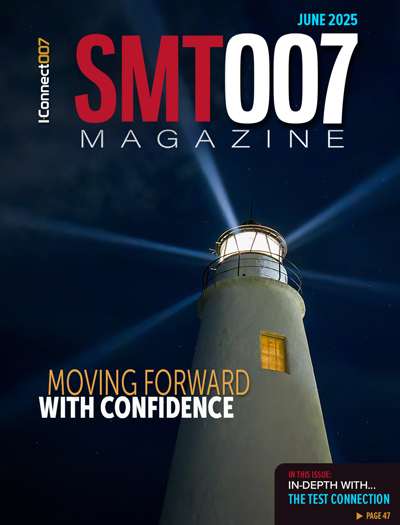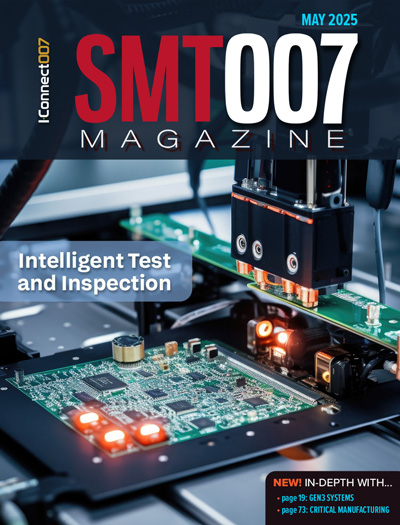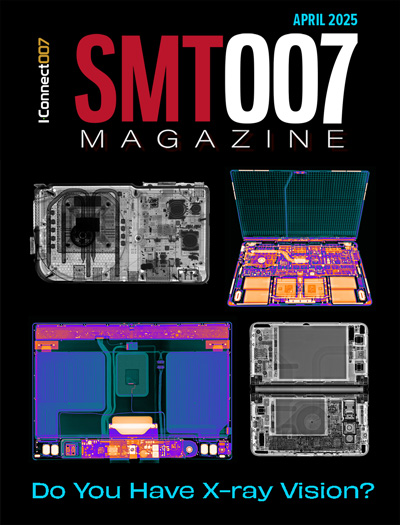-

- News
- Books
Featured Books
- smt007 Magazine
Latest Issues
Current Issue
Moving Forward With Confidence
In this issue, we focus on sales and quoting, workforce training, new IPC leadership in the U.S. and Canada, the effects of tariffs, CFX standards, and much more—all designed to provide perspective as you move through the cloud bank of today's shifting economic market.

Intelligent Test and Inspection
Are you ready to explore the cutting-edge advancements shaping the electronics manufacturing industry? The May 2025 issue of SMT007 Magazine is packed with insights, innovations, and expert perspectives that you won’t want to miss.

Do You Have X-ray Vision?
Has X-ray’s time finally come in electronics manufacturing? Join us in this issue of SMT007 Magazine, where we answer this question and others to bring more efficiency to your bottom line.
- Articles
- Columns
- Links
- Media kit
||| MENU - smt007 Magazine
NPL Webinar on Characterization of High-Temp Component Interconnect Materials
December 13, 2016 | National Physical LaboratoryEstimated reading time: 1 minute
Currently, for electronic assemblies to operate at high temperature, they must use a high lead solder or expensive gold based solder. In line with this, the UK's National Physical Laboratory (NPL) is being partnered with several end-users to better characterize alternatives for high temperature component interconnect to operate above 200°C. NPL has been part of a consortia to successfully develop innovative materials specifically designed to offer a Pb-free cost-effective alternative.
In addition to this, NPL is also holding a technical webinar, with the theme Characterization of High Temperature Component Interconnect Materials, on 10 January 2017, to be presented by Martin Wickham.
This presentation summarizes the work undertaken by the authors to develop and better understand this new family of electrical interconnection materials including updated long-term reliability data. The project brought together a materials supplier (GEM - Gwent Electronic Materials), an end-user (MSL - Microsemi), and a technology research organization (NPL) to jointly develop, test and implement in production, the solution based on silver-loaded silicone materials.
This presentation focuses on the testing and materials evaluation undertaken at NPL to determine the long-term performance of these alternative materials including high temperature ageing up to 300°C, thermal cycling and damp heat testing. Details of the shear strength and electrical performance of interconnects between the substrates and components during the test regimes are given. The manufacturing process is outlined, including details of the test vehicles utilized. The processing temperature for the conductive adhesive is 250 °C, which offers additional advantages in potential improvements in component and substrate reliability compared to soldered solutions, which would typically be processed at temperatures above 300°C.
Topics covered include:
- High temperature materials and applications
- Development of materials for HT
- Reliability results from two projects
- Long-term high temperature storage and mechanical testing
- Design issues and process failures
- Future requirements and testing
This webinar will run for between 45-60 minutes, with a Q&A session. The webinars are limited to 100 delegates/companies. A copy of each of the slides presented and links to NPL reports will be provided after the webinar.
For more information or to register, click here.
Suggested Items
Indium Corporation Expert to Present on Automotive and Industrial Solder Bonding Solutions at Global Electronics Association Workshop
06/26/2025 | IndiumIndium Corporation Principal Engineer, Advanced Materials, Andy Mackie, Ph.D., MSc, will deliver a technical presentation on innovative solder bonding solutions for automotive and industrial applications at the Global Electronics A
Fresh PCB Concepts: Assembly Challenges with Micro Components and Standard Solder Mask Practices
06/26/2025 | Team NCAB -- Column: Fresh PCB ConceptsMicro components have redefined what is possible in PCB design. With package sizes like 01005 and 0201 becoming more common in high-density layouts, designers are now expected to pack more performance into smaller spaces than ever before. While these advancements support miniaturization and functionality, they introduce new assembly challenges, particularly with traditional solder mask and legend application processes.
Knocking Down the Bone Pile: Tin Whisker Mitigation in Aerospace Applications, Part 3
06/25/2025 | Nash Bell -- Column: Knocking Down the Bone PileTin whiskers are slender, hair-like metallic growths that can develop on the surface of tin-plated electronic components. Typically measuring a few micrometers in diameter and growing several millimeters in length, they form through an electrochemical process influenced by environmental factors such as temperature variations, mechanical or compressive stress, and the aging of solder alloys.
SolderKing’s Successful Approach to Modern Soldering Needs
06/18/2025 | Nolan Johnson, I-Connect007Chris Ward, co-founder of the family-owned SolderKing, discusses his company's rapid growth and recent recognition with the King’s Award for Enterprise. Chris shares how SolderKing has achieved these award-winning levels of service in such a short timeframe. Their secret? Being flexible in a changing market, technical prowess, and strong customer support.
Preventing Surface Prep Defects and Ensuring Reliability
06/10/2025 | Marcy LaRont, PCB007 MagazineIn printed circuit board (PCB) fabrication, surface preparation is a critical process that ensures strong adhesion, reliable plating, and long-term product performance. Without proper surface treatment, manufacturers may encounter defects such as delamination, poor solder mask adhesion, and plating failures. This article examines key surface preparation techniques, common defects resulting from improper processes, and real-world case studies that illustrate best practices.


